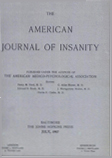Abstract
The main object of this communication is to report a study of 142 pairs of twins with so-called schizophrenic psychoses in one or both of the twins in each pair.
These twins are classified as follows: monozygotic 41 pairs; same-sex dizygotic 53 pairs; opposite-sex dizygotic 48 pairs.
There is a marked contrast between monozygotic and dizygotic twins with respect to the proportion of cases of both twins of the pair affected. These proportions are, respectively, 68.3 per cent and 14.9 per cent.
In the medical literature of twin pathology great stress has been laid on close similarity or even identicalness of manifestations, particularly in monozygotic twins. However, as regards the so-called schizophrenic psychoses, close similarity or identicalness of manifestations is the exception rather than the rule.
Instances of similar psychoses, quantitative dissimilarity (i. e., dissimilarity of age of onset, particular symptomatology, course, outcome, etc.), qualitative dissimilarity (i. e., one twin having a schizophrenic psychosis and the other some neuro-psychiatric condition belonging to a different clinical group, such as mental deficiency, epilepsy, etc.), and total discordance (i. e., one twin having a schizophrenic psychosis and the other not affected at all), are to be found among both monozygotic and dizygotic twins, but not with the same relative frequencies.
With reference to these points our material has been summarized in Table 3. The data thus revealed suggests the following general propositions:
1. In the etiology of so-called schizophrenic psychoses hereditary factors seem to play an important part.
2. The hereditary factors, in themselves, are often inadequate; that is to say, they do not suffice to produce a schizophrenic psychosis.
3. The pathogenic effect of the hereditary factors is not highly specific. Other factors often play a part with resulting dissimilarities of manifestation or total discordance of findings even in monozygotic twins.
4. Hereditary factors are not always present, therefore not essential, in the etiology of so-called schizophrenic psychoses.
A more detailed scrutiny of the material suggests the possibility of separating out, from amongst the so-called schizophrenic psychoses, a large group of cases which seem to occur on a basis of partial decerebration, mainly of traumatic or infectious origin.
The proportion of cases with a probable traumatic or infectious etiology seems to be higher in the male than in the female sex. The most prominent factor here seems to be cerebral birth trauma.
This is in harmony with other evidence, which we have published elsewhere, indicating a more marked cerebral vulnerability in male than in female fetuses and infants.
On the other hand, psychic factors in the etiology of so-called schizophrenic psychoses, especially in the sphere of sex or love life, seem to be more commonly found in women than in men.
As further evidence of the existence of at least two practically unrelated groups of psychoses among the so-called schizophrenias, attention is called to state hospital statistics pertaining to "dementia præcox." The two groups are unevenly distributed as to age and sex. While on the whole "dementia præcox" is somewhat more prevalent in the male sex, it is much more common in males than in females in the age group under 35, and is much more common in females than in males in the age group over 35.
In the group of cases which occur more characteristically in women and in later adult life and in which psychogenic factors appear more prominently in the etiology, hereditary factors seem to play a more important part than they do in the group characterized by a traumatic or infectious etiology.
In connection with psychotic disease resulting from intra-natal or post-natal trauma, the point must be specially stressed of its possible occurrence as a sequel following a seemingly insignificant trauma after an interval of 20 or more years.
We submit, as a part of our theory of so-called schizophrenic psychoses, that a large proportion of such psychoses originate in a cerebral trauma at birth or in childhood; that such cases are more prevalent in the male than in the female sex, and in young subjects than in those over 30 years of age; that the type of injury is often asymptomatic, or almost so, at the time of its occurrence; that it probably consists in subarachnoid and subpial hemorrhages upon the cerebral convexity in the frontal and parietal regions; and that it results in partial avulsion or detachment of the pia-arachnoid from the top and side surfaces of the gyri, causing interference with the blood supply, slow atrophy, and progressive impairment of mental function.
Further research is needed in this field. A series of 12 criteria is postulated as being demanded by our theory for the establishment of any given syndrome as a decerebration syndrome which may result from birth trauma.
An attempt to apply these criteria to the so-called schizophrenic psychoses reveals that for a roughly separable group of such psychoses 7 of the 12 criteria definitely fit.
Concerning the remaining five criteria nothing definite can be said either one way or the other on the basis of data which are readily available at this time. Certainly not one of them can be shown to not fit.
There is need for further research also in order to clarify the nature, mental mechanisms, symptomatology, and course of so-called schizophrenic psychoses which developed more characteristically in the thirties or later and more often in women than in men. Should it prove possible to isolate in a more clear-cut way this group of cases, opportunities would thereby be created for more definitely directed and more purposeful research along these lines too.

